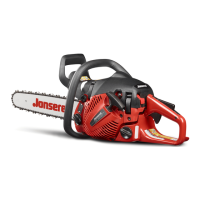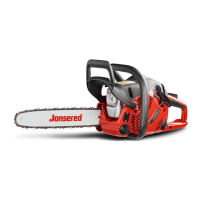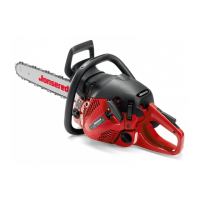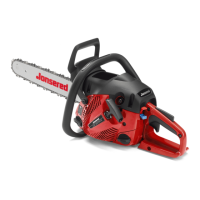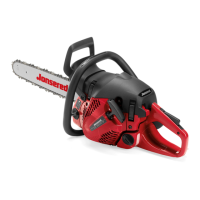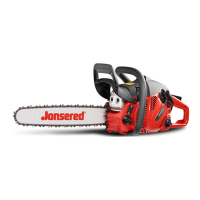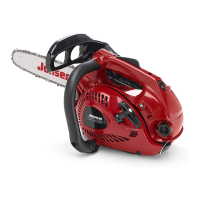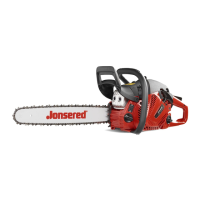Do you have a question about the Jonsered CS 2260 and is the answer not in the manual?
Explains symbols displayed on the chain saw itself for operational guidance and warnings.
Details symbols used within the operator's manual to convey information and instructions.
Identifies and explains various labels found on the chain saw for certification and safety.
A welcoming message from Jonsered to the new owner of the product.
Identifies and explains the various parts of the chain saw with numbered labels.
Essential checks and preparations before operating the chain saw for the first time.
Crucial safety guidelines and warnings for safe operation and accident prevention.
Emphasizes the importance of user judgment and caution in all operating situations.
Details essential protective gear required for safe chain saw operation.
Explains the safety features built into the machine and their functions.
Describes the function and operation of the chain brake and front hand guard for kickback protection.
Explains the throttle lockout mechanism and the function of the chain catcher.
Details the role of the right hand guard and the vibration damping system for user comfort.
Warns about potential health risks from vibration and the importance of the muffler.
Provides general rules for choosing and maintaining cutting equipment for safety and performance.
Discusses how guide bars and saw chains can be selected to reduce kickback risk.
Defines key terms and specifications related to saw chains and guide bars for proper selection.
Details the process of sharpening cutting teeth and adjusting the depth gauge for optimal performance.
Explains how to adjust the depth gauge and tension the saw chain correctly.
Emphasizes the importance of proper lubrication for cutting equipment to prevent damage and ensure safety.
Guides on filling, checking, and troubleshooting the chain lubrication system.
Covers inspection of the drive sprocket and lubrication of the needle bearing.
Outlines daily checks for wear and damage on the saw chain and its components.
Details how to check the guide bar for wear and the importance of regular turning.
Step-by-step instructions for mounting the guide bar and saw chain onto the chainsaw.
Provides guidance on mixing fuel, recommended fuel types, and running-in procedures.
Advises on the type of chain oil to use and precautions regarding oil viscosity and waste oil.
Details safety measures to take when refueling the chainsaw to prevent fire hazards.
Provides instructions for safely transporting and storing the chainsaw and fuel.
Step-by-step instructions for starting the chainsaw with both cold and warm engines.
Explains how to stop the engine and reiterates essential safety practices.
Lists essential checks to perform on the chainsaw before each use for safety and functionality.
Provides fundamental safety rules and advice for operating the chainsaw effectively.
Covers general safety aspects like situational awareness and safe working practices.
Details proper grip, stable footing, and safe cutting techniques to maintain control.
Offers advice on preventing kickback and safely cutting logs into manageable pieces.
Explains basic cutting methods and how to identify and avoid kickback risks.
Provides guidance on limbing and how to safely cut branches, especially those under tension.
Addresses techniques for cutting logs based on their support and risk of splitting or jamming.
Introduces tree felling, emphasizing experience needed and maintaining a safe distance.
Explains how to control felling direction using directional and felling cuts.
Covers techniques for safely freeing trapped trees and cutting branches under tension.
Detailed explanation of kickback causes and how to prevent it through technique.
Specific techniques for limbing and processing felled trunks into logs.
Explains how to adjust the carburetor, including the automatic CarbControl function.
Details procedures for inspecting and maintaining critical safety components like the chain brake.
Covers checks for the inertia brake release and throttle lockout mechanisms.
Outlines checks for the chain catcher and right hand guard for proper function and damage.
Describes how to inspect the vibration damping system and test the stop switch.
Details muffler inspection, cleaning, and the importance of the spark arrestor screen.
Instructions for changing a broken starter cord and recoil spring.
Guides on cleaning and replacing the air filter to prevent engine issues.
Covers checking the spark plug, electrode gap, and lubricating the bar tip sprocket.
Details the regular lubrication required for the needle bearing in the clutch drum.
Explains oil pump adjustment and the importance of the cooling system for engine longevity.
Describes centrifugal cleaning and preparations for winter operation.
Details adjustments for running the machine in cold weather to prevent icing.
Explains the features of heated handles and electrical carburetor heating for specific models.
Provides a comprehensive schedule for regular maintenance tasks.
Lists technical data for the motor, including displacement, bore, stroke, and ignition system.
Details fuel tank capacity, oil pump capacity, weight, and chain/bar specifications.
Lists approved guide bar and saw chain combinations for USA models.
Provides information on saw chain filing techniques and necessary file gauges.
Explains the owner's rights, responsibilities, and the scope of the emission control warranty.
Detailed safety measures specifically addressing kickback risks and prevention.
Covers additional general safety measures for chain saw users, including one-handed operation and fatigue.
Explains symbols displayed on the chain saw itself for operational guidance and warnings.
Details symbols used within the operator's manual to convey information and instructions.
Identifies and explains various labels found on the chain saw for certification and safety.
A welcoming message from Jonsered to the new owner of the product.
Identifies and explains the various parts of the chain saw with numbered labels.
Essential checks and preparations before operating the chain saw for the first time.
Crucial safety guidelines and warnings for safe operation and accident prevention.
Emphasizes the importance of user judgment and caution in all operating situations.
Details essential protective gear required for safe chain saw operation.
Explains the safety features built into the machine and their functions.
Describes the function and operation of the chain brake and front hand guard for kickback protection.
Explains the throttle lockout mechanism and the function of the chain catcher.
Details the role of the right hand guard and the vibration damping system for user comfort.
Warns about potential health risks from vibration and the importance of the muffler.
Provides general rules for choosing and maintaining cutting equipment for safety and performance.
Discusses how guide bars and saw chains can be selected to reduce kickback risk.
Defines key terms and specifications related to saw chains and guide bars for proper selection.
Details the process of sharpening cutting teeth and adjusting the depth gauge for optimal performance.
Explains how to adjust the depth gauge and tension the saw chain correctly.
Emphasizes the importance of proper lubrication for cutting equipment to prevent damage and ensure safety.
Guides on filling, checking, and troubleshooting the chain lubrication system.
Covers inspection of the drive sprocket and lubrication of the needle bearing.
Outlines daily checks for wear and damage on the saw chain and its components.
Details how to check the guide bar for wear and the importance of regular turning.
Step-by-step instructions for mounting the guide bar and saw chain onto the chainsaw.
Provides guidance on mixing fuel, recommended fuel types, and running-in procedures.
Advises on the type of chain oil to use and precautions regarding oil viscosity and waste oil.
Details safety measures to take when refueling the chainsaw to prevent fire hazards.
Provides instructions for safely transporting and storing the chainsaw and fuel.
Step-by-step instructions for starting the chainsaw with both cold and warm engines.
Explains how to stop the engine and reiterates essential safety practices.
Lists essential checks to perform on the chainsaw before each use for safety and functionality.
Provides fundamental safety rules and advice for operating the chainsaw effectively.
Covers general safety aspects like situational awareness and safe working practices.
Details proper grip, stable footing, and safe cutting techniques to maintain control.
Offers advice on preventing kickback and safely cutting logs into manageable pieces.
Explains basic cutting methods and how to identify and avoid kickback risks.
Provides guidance on limbing and how to safely cut branches, especially those under tension.
Addresses techniques for cutting logs based on their support and risk of splitting or jamming.
Introduces tree felling, emphasizing experience needed and maintaining a safe distance.
Explains how to control felling direction using directional and felling cuts.
Covers techniques for safely freeing trapped trees and cutting branches under tension.
Detailed explanation of kickback causes and how to prevent it through technique.
Specific techniques for limbing and processing felled trunks into logs.
Explains how to adjust the carburetor, including the automatic CarbControl function.
Details procedures for inspecting and maintaining critical safety components like the chain brake.
Covers checks for the inertia brake release and throttle lockout mechanisms.
Outlines checks for the chain catcher and right hand guard for proper function and damage.
Describes how to inspect the vibration damping system and test the stop switch.
Details muffler inspection, cleaning, and the importance of the spark arrestor screen.
Instructions for changing a broken starter cord and recoil spring.
Guides on cleaning and replacing the air filter to prevent engine issues.
Covers checking the spark plug, electrode gap, and lubricating the bar tip sprocket.
Details the regular lubrication required for the needle bearing in the clutch drum.
Explains oil pump adjustment and the importance of the cooling system for engine longevity.
Describes centrifugal cleaning and preparations for winter operation.
Details adjustments for running the machine in cold weather to prevent icing.
Explains the features of heated handles and electrical carburetor heating for specific models.
Provides a comprehensive schedule for regular maintenance tasks.
Lists technical data for the motor, including displacement, bore, stroke, and ignition system.
Details fuel tank capacity, oil pump capacity, weight, and chain/bar specifications.
Lists approved guide bar and saw chain combinations for USA models.
Provides information on saw chain filing techniques and necessary file gauges.
Explains the owner's rights, responsibilities, and the scope of the emission control warranty.
Detailed safety measures specifically addressing kickback risks and prevention.
Covers additional general safety measures for chain saw users, including one-handed operation and fatigue.

